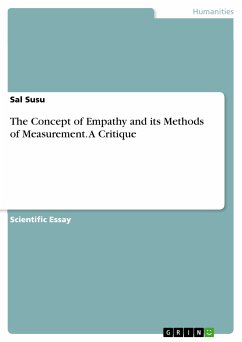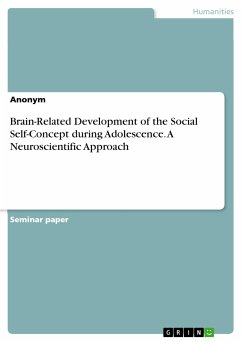
The Concept of Empathy and its Methods of Measurement. A Critique (eBook, PDF)
Sofort per Download lieferbar
Statt: 17,95 €**
15,99 €
inkl. MwSt. und vom Verlag festgesetzt.
**Preis der gedruckten Ausgabe (Broschiertes Buch)
Weitere Ausgaben:

PAYBACK Punkte
0 °P sammeln!
Scientific Essay from the year 2020 in the subject Psychology - Personality Psychology, grade: A+, , language: English, abstract: This work deals with the concept of empathy and critique of tests that are used to measure this concept. The exact definition of the construct of empathy has been a subject of debate ever since the term was coined by Edward Titchener in 1909. He used the older German concept of "Einfühlung", which meant projecting one's feelings onto an external object. In other words, getting somebody to feel what one is currently feeling. Titchener's concept of empathy was broade...
Scientific Essay from the year 2020 in the subject Psychology - Personality Psychology, grade: A+, , language: English, abstract: This work deals with the concept of empathy and critique of tests that are used to measure this concept. The exact definition of the construct of empathy has been a subject of debate ever since the term was coined by Edward Titchener in 1909. He used the older German concept of "Einfühlung", which meant projecting one's feelings onto an external object. In other words, getting somebody to feel what one is currently feeling. Titchener's concept of empathy was broader, including the awareness of another person's affective state, which includes their thoughts and emotions; as well as sharing other peoples' feelings. Another theorist, Edmund Husserl, defined empathy as putting oneself into the shoes of another person. However, George Herbert Mead's definition is the most basic one used today: the ability to role-take, or understand another person's current situation, and adjust one's own behaviour in response, for example, by acting prosocially. Therefore, at a broad level, most definitions of empathy include an affective component, that is, feeling other peoples' emotions, which can be positive or negative. For example, feeling happy because somebody else is displaying outward signs or expressions of happiness such as laughter. Empathy also includes a cognitive component, which means pushing aside one's own current point of view, and trying to see situations from another person's vantage point by using one's imagination.
Dieser Download kann aus rechtlichen Gründen nur mit Rechnungsadresse in A, B, BG, CY, CZ, D, DK, EW, E, FIN, F, GR, HR, H, IRL, I, LT, L, LR, M, NL, PL, P, R, S, SLO, SK ausgeliefert werden.













